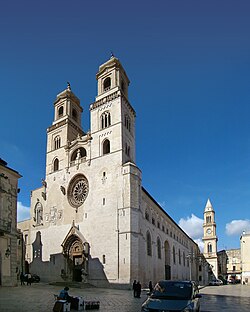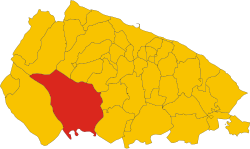Altamura
| Altamura | ||
|---|---|---|
| Comune | ||
| Comune di Altamura | ||

|
||
|
||
 Altamura within the Province of Bari |
||
| Location of Altamura in Italy | ||
| Coordinates: 40°49′N 16°33′E / 40.817°N 16.550°E | ||
| Country | Italy | |
| Region |
|
|
| Province / Metropolitan city | Bari (BA) | |
| Frazioni | Casal Sabini, Fornello, Madonna del Buon Cammino, Marinella, Masseria Franchini, Pescariello, Sanuca | |
| Government | ||
| • Mayor | Mario Antonio Felice Stacca | |
| Area | ||
| • Total | 427 km2 (165 sq mi) | |
| Elevation | 450 m (1,480 ft) | |
| Population (October 2012) | ||
| • Total | 69,738 | |
| • Density | 160/km2 (420/sq mi) | |
| Demonym(s) | Altamurani | |
| Time zone | CET (UTC+1) | |
| • Summer (DST) | CEST (UTC+2) | |
| Postal code | 70022 | |
| Dialing code | 080 | |
| Patron saint | Sant'Irene | |
| Saint day | May 5 | |
| Website | Official website | |
Altamura [ˌaltaˈmuːra] is a city and comune of Apulia, in southern Italy. It is located on one of a hill of the Murge plateau in the province of Bari, 45 kilometres (28 miles) southwest of Bari, close to the border with Basilicata. As of 2011[update] its population was 70,288.
The city is known for its particular quality of bread called Pane di Altamura, which is sold in numerous other Italian cities. According to the Latin poet Horace: "...for water is sold here, though the worst in the world; but their bread is exceeding fine, inasmuch that the weary traveler is used to carry it willingly on his shoulders."
The 130,000-year-old calcified Altamura Man was discovered in the nearby limestone cave called the grotta di Lamalunga.
The area of modern Altamura was densely settled in the Bronze Age (La Croce settlement and necropolis).
The ancient city was known as Altilia, from Alter Ilium, the "other Troy". According to a legend, it was founded by a friend of Aeneas, Antellus, also a fugitive from the Asian city destroyed by the Greeks. Another legend attributes the foundation to Althea, queen of the Myrmidons.
The region contains some fifty tumuli. Between the 6th and the 3rd century BCE a massive line of megalithic walls was erected. From the following century, however, the importance of the city decayed. It recovered some importance when the Emperor Frederick II refounded the city and ordered the construction of the large Altamura Cathedral in 1232, which became one of the most venerated sanctuaries in Apulia. In 1248, under pressure from Frederick, Pope Innocent IV declared Altamura exempt from the jurisdiction of the bishop of Bari, making it a "palatine church", that is the equivalent of a palace chapel.
...
Wikipedia


